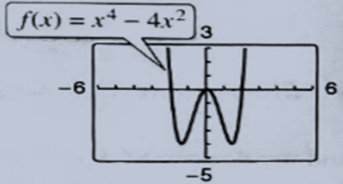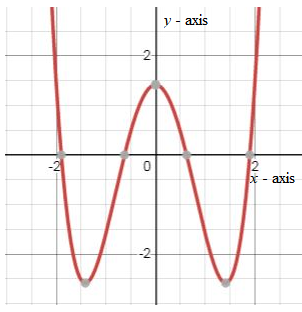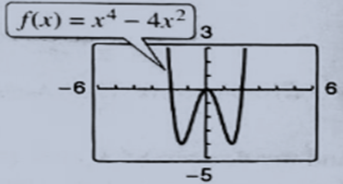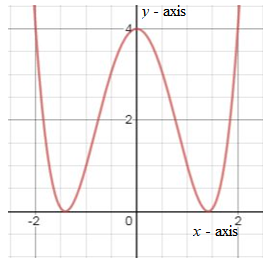
Concept explainers
a.
To find: The possible translation of equation so that function has four distinct real zeroes.
a.
Answer to Problem 76E
Explanation of Solution
Given information:
The given graph has an equation of
Formula used:
Given equation is a polynomial equation with degree
The standard form of a polynomial in 4th degree will be
By definition, a
As asked in the question, for translating an equation,change is made in the constant that is e.
For four distinct real zeroes the graph should attain value of
Looking at the graph it can be derived that if the value e has any value between

Conclusion:
For having four real distinct zeroes the equation must be translated as
b.
To find: The possible translation of equation so that function has two real zeroes, each of multiplicity
b.
Answer to Problem 76E
Explanation of Solution
Given information:
The given graph has an equation of
Formula used:
Given equation is a polynomial equation with degree
The standard form of a polynomial in
By definition, a
As asked in the question, for translating an equation change is made in the constant that is e.
For having
The graph will touch at x-axis at only
The remaining two roots will be imaginary.

Conclusion:
To translate the graph in such a way that it has two real zeroes each of multiplicity it should be written/translated as
c.
To find: The possible translation of equation so that function has two real zeroes and two imaginary zeroes.
c.
Answer to Problem 76E
Explanation of Solution
Given information:
The given graph has an equation of
Formula used:
Given equation is a polynomial equation with degree
The standard form of a polynomial in
By definition, a
As asked in the question, for translating an equation change is made in the constant that is e.
For having
For doing so the graph should be moved towards negative y-axis such that e has value between

Conclusion:
To translate the equation such that it has 2 real and 2 imaginary zeroes, the equation must be written as
Here the negative sign indicates that the graph has to be moved towards the negative y-axis.
d.
To find: The possible translation of equation so that function has four imaginary zeroes.
d.
Answer to Problem 76E
Explanation of Solution
Given information:
The given graph has an equation of
Formula used:
Given equation is a polynomial equation with degree
The standard form of a polynomial in
By definition, a
As asked in the question, for translating an equation change is made in the constant that is e.
For having all
This can be achieved only if the value of e is greater than

Conclusion:
The equation must be translated as
Chapter 2 Solutions
EP PRECALC.GRAPHING APPR.-WEBASSIGN-1YR
- Force with 800 N and 400 N are acting on a machine part at 30° and 60°, respectively with a positive x axis, Draw the diagram representing this situationarrow_forwardI forgot to mention to you to solve question 1 and 2. Can you solve it using all data that given in the pict i given and can you teach me about that.arrow_forwardexam review please help!arrow_forward
 Calculus: Early TranscendentalsCalculusISBN:9781285741550Author:James StewartPublisher:Cengage Learning
Calculus: Early TranscendentalsCalculusISBN:9781285741550Author:James StewartPublisher:Cengage Learning Thomas' Calculus (14th Edition)CalculusISBN:9780134438986Author:Joel R. Hass, Christopher E. Heil, Maurice D. WeirPublisher:PEARSON
Thomas' Calculus (14th Edition)CalculusISBN:9780134438986Author:Joel R. Hass, Christopher E. Heil, Maurice D. WeirPublisher:PEARSON Calculus: Early Transcendentals (3rd Edition)CalculusISBN:9780134763644Author:William L. Briggs, Lyle Cochran, Bernard Gillett, Eric SchulzPublisher:PEARSON
Calculus: Early Transcendentals (3rd Edition)CalculusISBN:9780134763644Author:William L. Briggs, Lyle Cochran, Bernard Gillett, Eric SchulzPublisher:PEARSON Calculus: Early TranscendentalsCalculusISBN:9781319050740Author:Jon Rogawski, Colin Adams, Robert FranzosaPublisher:W. H. Freeman
Calculus: Early TranscendentalsCalculusISBN:9781319050740Author:Jon Rogawski, Colin Adams, Robert FranzosaPublisher:W. H. Freeman
 Calculus: Early Transcendental FunctionsCalculusISBN:9781337552516Author:Ron Larson, Bruce H. EdwardsPublisher:Cengage Learning
Calculus: Early Transcendental FunctionsCalculusISBN:9781337552516Author:Ron Larson, Bruce H. EdwardsPublisher:Cengage Learning





